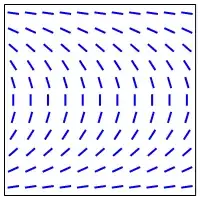First of all, I am very comfortable with the tensor product of vector spaces. I am also very familiar with the well-known generalizations, in particular the theory of monoidal categories. I have gained quite some intuition for tensor products and can work with them. Therefore, my question is not about the definition of tensor products, nor is it about its properties. It is rather about the mental images. My intuition for tensor products was never really geometric. Well, except for the tensor product of commutative algebras, which corresponds to the fiber product of the corresponding affine schemes. But let's just stick to real vector spaces here, for which I have some geometric intuition, for example from classical analytic geometry.
The direct product of two (or more) vector spaces is quite easy to imagine: There are two (or more) "directions" or "dimensions" in which we "insert" the vectors of the individual vector spaces. For example, the direct product of a line with a plane is a three-dimensional space.
The exterior algebra of a vector space consists of "blades", as is nicely explained in the Wikipedia article.
Now what about the tensor product of two finite-dimensional real vector spaces $V,W$? Of course $V \otimes W$ is a direct product of $\dim(V)$ copies of $W$, but this description is not intrinsic, and also it doesn't really incorporate the symmetry $V \otimes W \cong W \otimes V$. How can we describe $V \otimes W$ geometrically in terms of $V$ and $W$? This description should be intrinsic and symmetric.
Note that SE/115630 basically asked the same, but received no actual answer. The answer given at SE/309838 discusses where tensor products are used in differential geometry for more abstract notions such as tensor fields and tensor bundles, but this doesn't answer the question either. (Even if my question gets closed as a duplicate, then I hope that the other questions receive more attention and answers.)
More generally, I would like to ask for a geometric picture of the tensor product of two vector bundles on nice topological spaces. For example, tensoring with a line bundle is some kind of twisting. But this is still some kind of vague. For example, consider the Möbius strip on the circle $S^1$, and pull it back to the torus $S^1 \times S^1$ along the first projection. Do the same with the second projection, and then tensor both. We get a line bundle on the torus, okay, but how does it look like geometrically?
Perhaps the following related question is easier to answer: Assume we have a geometric understanding of two linear maps $f : \mathbb{R}^n \to \mathbb{R}^m$, $g : \mathbb{R}^{n'} \to \mathbb{R}^{m'}$. Then, how can we imagine their tensor product $f \otimes g : \mathbb{R}^n \otimes \mathbb{R}^{n'} \to \mathbb{R}^m \otimes \mathbb{R}^{m'}$ or the corresponding linear map $\mathbb{R}^{n n'} \to \mathbb{R}^{m m'}$ geometrically? This is connected to the question about vector bundles via their cocycle description.



On the other hand, the 2-nd symmetric power consists of ellipsoids. :)
– Alexander Shamov Oct 15 '13 at 19:50